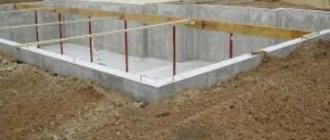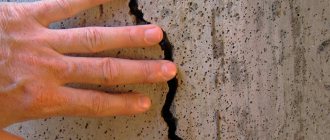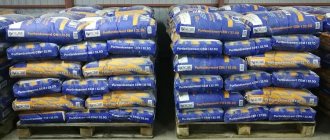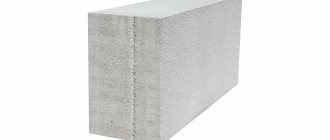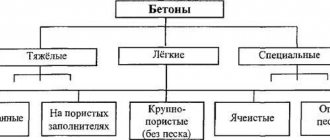Types and purpose
The strength and durability of concrete structures is ensured by the quality and water resistance of the brand of concrete that is used to fill the form. That is why the trays are based on a mixture of a grade no lower than M-200. In addition, the base is made of class A reinforcement rods or Bp-I grade wire base. The quality of the finished product is regulated by the requirements of GOST 21509-85.
Here are the main parameters that are specified in GOST:
- moisture resistance and ability to withstand frost;
- resistance to corrosion of metal parts and fittings;
- thickness and density of the concrete layer;
- general characteristics of the concrete mixture;
- resistance of the finished product to mechanical stress;
- the presence of voids in the cavity of the product.
Depending on the ratio of all the above parameters, there are three directions for using concrete drainage trays:
- drainage - function;
- for laying cables;
- to protect the heating main.
back to menu ↑
Prices ↑
Concrete drainage trays with gratings are made from fairly inexpensive raw materials, which ultimately allows you to purchase equipment at very competitive prices.
Basically, prices for equipment vary depending on the technical characteristics of the product, throughput, dimensions, and purpose.
For example, trays weighing 7 kg can be sold at a price of 180 rubles. per piece , and trays weighing 25 kg cost 330 rubles .
If we take into account the height of the equipment, then for a height from 60 to 125 mm , the price will be from 180 to 130 rubles , for a height from 80 to 100 mm , prices can vary from 420 to 430 rubles , products with a height of 132 - 157 mm will be sold at 440 -450 rub. per piece , and with a height of 182 mm at a price of 260 rubles .
Prices will vary depending on the type of product:
- with slotted grille;
- with cast iron drainage;
- simple;
- with vertical drain.
Prices for such equipment may vary significantly depending on who supplies the product.
If the products are sold directly by the manufacturer, the buyer can count on affordable prices; if the goods are supplied by many intermediaries, the prices are significantly more expensive.
When purchasing trays, you can count on discounts and promotional offers if the purchase is wholesale.
Concrete products will be significantly lower in price than plastic or products made from other materials.
Therefore, they are more popular not only due to their properties and characteristics, but also to their significantly economical price.
Let's take a closer look at drainage trays
From the name of the product it is clear that they are used to organize drainage systems and drains. Functions performed by these products:
- Providing drainage, that is, removing excess moisture from the surrounding soil.
- Moisture redistribution. Removing water from the road surface and transporting it to the side of the road or slopes.
- Organization of channels for water outflow.
- Ensuring the outflow of storm water.
- Sewage function - connections of drainage systems with collectors.
Types of drainage trays
In accordance with GOST, there are three main types:
- in the form of a trapezoid;
- in the form of the letter P;
- in the form of a parabola.
At the same time, the first and second types can be either with a flat, flat internal base, or in the form of a round gutter. All the main characteristics, as well as the scope of their application, can be found out from the markings. It is especially important to study the markings when constructing or installing pipelines in difficult natural conditions. For example, when laying tracks in soil subject to seasonal fluctuations: swampy terrain, the presence of a clay layer, the presence of groundwater.
This also includes work that is carried out in the far north. The most important requirement here is resistance to low temperatures. Drainage trays are marked with the letter L, and two numbers indicate the series number and the maximum vertical load.
For ease of installation, trays come in two types: prefabricated and integral. Common models: length ranges from 0.72 meters to 6 meters, width from 0.4 meters to 1.84 meters, edge height from 0.38 meters to 1.32 meters.
back to menu ↑
Gutters. Dimensions and purpose
The cross-section of the gutters can be U-shaped or have an original shape that corresponds to the general design concept of the building facade. Considering that gutters are often used as one of the elements of the drainage system, the first thing you need to study before carrying out installation work is the manufacturer’s recommendations set out in the installation instructions. The fastening of gutters begins with the installation of brackets to the base of the rafters or to the eaves board with a maximum step of 1 m, usually it does not exceed 0.5 m - it all depends on the materials used: for copper products - mm, for lighter ones - mm.
The optimal slope of gutters is 2 mm per 1 p. A few more recommendations regarding the position of gutters relative to the roof plane:. Installing elements of a drainage system is not particularly difficult. At the same time, its presence protects the foundation of the house and the areas adjacent to the construction from waterlogging, and the gutters, funnels and pipes themselves can become an excellent decoration for the facade. Calculation of a pipe for draining excess water from a site involves calculating and selecting the diameter of the pipes from which the drainage systems will be installed.
You can calculate this parameter yourself or use the services of specialists. An installed storm sewer pipe diameter, in which the diameter is selected correctly, can cope with any volume of wastewater, including heavy rainfalls and heavy floods.
Our company is engaged in the sale of reinforced concrete products in various directions. Such products also include drainage trays, the price of which is quite reasonable. Drainage trays are usually used for installation in pedestrian areas and parking lots, driveways, as well as sports facilities. These products are made from fiber-reinforced concrete by vibrocompression. Shallow gutters made of reinforced concrete, which are produced in the form of small sections, are designed to collect and drain surface water in places where the immersion depth of balconies, garages, and roofs is limited.
This means that the diameter of storm pipes is one of the main parameters when drawing up the design of the entire storm sewer network. To correctly calculate the diameter of a storm sewer pipe, the following work is required: For a medium-sized garden plot, the most suitable pipe diameter is mm.
Concrete trays for the construction of heating mains
The main purpose of these trays is to reliably protect the pipeline from corrosion, reduce heat loss and protect pipes from rodents. For sewerage and heating mains I use two types of trays:
- GOST Klp - these trays are covered with removable lids;
- GOST Kls - connection using channel fasteners.
The advantage of concrete trays over their brick counterparts:
- saving time and effort during installation due to the simplicity and integrity of the structure;
- significant cost reduction due to reduction of consumables;
- significant superiority in load-bearing capacity;
- ability to withstand sudden temperature changes and soil fluctuations.
back to menu ↑
Types of trays and their sizes
When constructing drainage systems, reinforced concrete trays of regular and telescopic shape, as well as stop blocks, are used. The basic requirements for their production and use are contained in a special regulatory document - Series 3.503.1-66. Below we will look at especially commonly used types of these structures.
Regular trays
Reinforced concrete structures have a U-shaped cross-section and an elongated shape. The trays are installed with the open side up and guarantee a stable flow of water in the specified volumes. Such trays are designed to drain water along a horizontal plane with a slight slope.
The most commonly used trays are L-1 and L-2. These structures have the same length (1990 mm) and height (680 mm) of the sides, but differ in width. Concrete tray L-1 is 1280 mm wide, and modification L-2 is 880 mm wide. Modification L-1 is used in cases where more intense water flow is expected.
Telescopic trays
These trays have a narrowed shape on one side. It makes it possible to insert one such tray into another and make a composite drainage channel. Channels are placed to ensure the flow of water from the pavement into the base of the subgrade on the slopes of the embankment.
The most popular standard sizes of telescopic concrete trays are designs B-6 and B-7. Tray B-6 is smaller in size: its length is 520 mm, and its width and height are 430x200 mm in the narrowed part and 540x250 in the wide part. Tray B-7 allows more water to pass through, since its cross-sectional dimensions are 888x450 mm in the wide part and 716x340 mm in the narrow part, and the length reaches 1500 mm.
Stop blocks
Stop blocks B-9 and B-9a are the support of composite channels, which are constructed from trays B-6 and B-7, respectively. Blocks are dug into the ground at the base of the embankment to prevent the flume channel from sliding down. The special shape of the stop blocks helps not to create an obstacle to the flow of water.
The dimensions of the B-9 block are 800x510x250 mm, and the B-9a differs from it in width, which reaches 730 mm. The blocks are made solid, which gives them the mass required to carry out their functions.
__________________________________________________
ACCEPTANCE RULES AND TEST METHODS
3.1. Trays should be accepted in batches in accordance with the requirements of GOST 13015.1-81 and this standard. The number of trays in a batch should be no more than:
200 - for trays with a height of 400-800 mm;
100 - for trays with a height of 1000 mm.
3.2. Acceptance of trays in terms of frost resistance and water resistance of concrete should be carried out based on the results of periodic tests.
3.3. Acceptance of trays in terms of their water resistance, concrete strength (compressive strength grade and tempering strength), compliance of reinforcement and embedded products with design documentation, strength of welded joints, accuracy of geometric parameters, thickness of the protective layer of concrete to the reinforcement, opening width of shrinkage cracks, concrete category surface inspections should be carried out based on the results of acceptance tests and inspections.
The water resistance test should be carried out on 1% of the trays from the batch, but not less than two trays.
3.4. Acceptance of trays in terms of the accuracy of geometric parameters, the thickness of the protective layer of concrete to the reinforcement, the quality of concrete surfaces, controlled by measurements, should be carried out according to the results of a single-stage selective control.
3.5. The dimensions of the trays, the position of the mounting loops, the thickness of the protective layer of concrete to the reinforcement, as well as the quality of the surfaces and the appearance of the trays are checked according to GOST 13015-75.
The wall thickness is measured at the ends of the trays evenly along the perimeter of the tray cross-section at at least five points.
The non-perpendicularity of the end planes of the tray to its longitudinal axis is determined by measuring the largest gap between the end plane of the tray and a metal testing square installed at right angles to the side of the tray.
Determination of the thickness of the protective layer of concrete, the size and location of reinforcement can also be done by scanning with ionizing radiation according to GOST 17625-83.
3.6. The compressive strength of concrete should be determined according to GOST 10180-78.
Monitoring and assessment of the homogeneity and strength of concrete trays should be carried out in accordance with GOST 18105.1-80.
If during the inspection it is established that the actual tempering strength of the concrete of the trays is lower than the required tempering strength, then the trays should be delivered to the consumer after the concrete reaches a strength corresponding to the grade of concrete in terms of compressive strength.
3.7. Frost resistance of concrete should be determined according to GOST 10060-76, water resistance of concrete - according to GOST 12730.5-78.
3.1.-3.7. (Changed edition, Amendment No. 1).
3.8, 3.9. (Excluded, Amendment No. 1).
3.10. Testing of trays for water resistance is carried out on a special stand according to the diagram shown in Fig. 2, in the following order.
Scheme of hydrostatic testing of a tray for water tightness
1
- test tray;
2
— shortened tray (2 pcs.);
3
- plugs;
4
— tray supports;
5
- gasket
Crap. 2
When transporting trays by rail, they must be loaded and secured in accordance with current instructions for the transportation of goods approved by the Ministry of Railways.
After applying each load step, the tray is kept under this load for 15 minutes and the tray is inspected to detect cracks, leaks or wet spots.
A tray completely filled with water is kept for 24 hours.
3.11. A batch of trays is considered to have passed the water resistance test if in all trays selected from this batch in the quantity established in clause 3.3, one day after filling, no water filtration in the form of wet spots or leaks is detected.
If unsatisfactory test results are obtained on at least one tray, re-test twice the number of samples taken from the same batch. If the result of repeated tests is unsatisfactory, the batch is considered to have failed the test.
3.10, 3.11. (Changed edition, Amendment No. 1).


